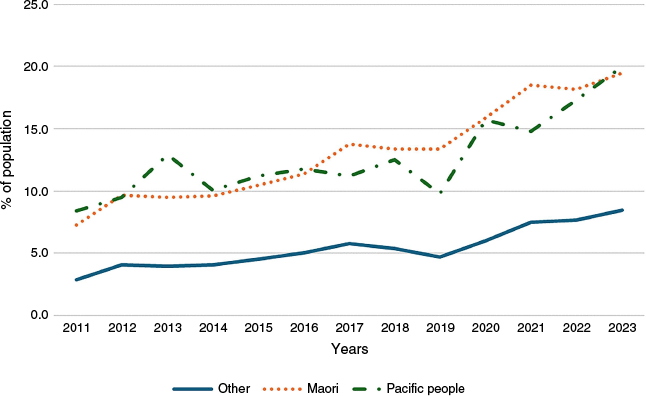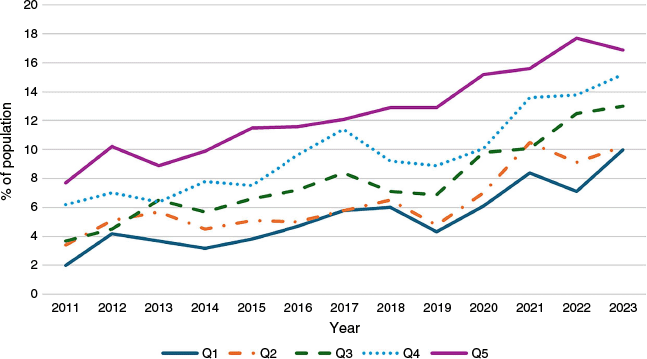Trends in psychological distress: analysis of NZ health survey data (2011–2023)
Steven Lillis 1 *
1 *
1
Abstract
Globally, mental health problems are increasing, particularly among youth, women, Indigenous populations, and those facing socioeconomic disadvantage. Aotearoa New Zealand (NZ) mirrors these trends, raising concerns about the capacity of primary care to respond.
This study aimed to analyse psychological distress trends in NZ from 2011 to 2023 and assess implications for primary health care.
Data from the New Zealand Health Survey were used, focusing on Kessler 10 scores ≥12, classified as high or very high psychological distress. Results were stratified by age, gender, ethnicity, and deprivation.
Overall rates of distress rose significantly. Among females aged 15–24 years, distress increased from 6 to 30%. Māori and Pacific peoples showed consistently higher distress rates, with widening disparities. The most socioeconomically deprived groups (Quintile 5) had the highest distress levels in all years of study data.
The findings highlight an escalating mental health burden managed predominantly in primary care. Workforce shortages, limited continuity of care, and structural inequities restrict the sector’s ability to respond. Urgent investment in culturally responsive, integrated, and equitable mental health services is required.
Keywords: ethnic groups, health inequities, health surveys, mental health services, primary health care, psychological distress, socioeconomic factors, young adults.
Introduction
Mental health disorders represent one of the leading causes of disability worldwide, with a growing global burden across all age groups. Although these conditions affect people across all demographics, certain populations carry a disproportionate share of this burden. Notably, Indigenous peoples in colonised nations, women, adolescents, and those living in socioeconomically deprived environments experience significantly higher rates of mental health challenges.1–3 In Aotearoa New Zealand (NZ), Māori and Pacific peoples consistently report higher psychological distress than the general population, reflecting poorer overall health outcomes for these people as well as those living in material deprivation.4–6
Women are particularly affected, experiencing approximately twice the rate of depression and anxiety compared to men, but young men have particular vulnerabilities where loneliness with unhelpful attitudes to both masculinity and mental health increase suicidality.7,8 Youth, defined by the WHO as individuals aged 15–24 years, are another high-risk group. Epidemiological studies show that the majority of lifetime mental illnesses emerge before the age of 25 years.9 Furthermore, there appears to be a cumulative effect whereby causes combine to worsen outcomes.10 These early-onset conditions include anxiety disorders, mood disorders, and psychotic disorders. Early intervention is critical, as untreated mental health conditions during this developmental period can have lifelong consequences on education, employment, and social functioning.
Recent global trends among youth are particularly concerning. Depression, anxiety, and suicidal ideation have increased significantly in the past decade, with adolescent depression rates rising from 24 to 37% between 2011 and 2020.11 Suicide rates in individuals aged 10–24 years in the U.S. increased from 6.8 to 10.6 per 100,000 between 2007 and 2017.12 Similar patterns have been observed in NZ. Drivers of this trend include increased loneliness, cyberbullying, unrealistic social comparisons through social media, precarious employment, financial stress, and climate anxiety.13–16 These compounding stressors are especially pronounced in young women.
In NZ, general practitioners (GPs) provide the majority of mental health care, managing mild to moderate conditions and serving as a gateway to specialist services. About 30% of GP consults have a mental health component.17 However, the primary care sector is under considerable strain. GP shortages, especially in rural and high-needs urban areas, are reducing access and undermining continuity of care.18 Workforce burnout, underfunding, and episodic care models limit the capacity of GPs to provide comprehensive mental health support.19 Against this backdrop, it is critical to understand population-level trends in psychological distress to inform health policy and service design.
Methods
This study analysed publicly available data from the New Zealand Health Survey (NZHS), an annual, nationally representative survey that collects information on various health indicators, including mental health. Each year, approximately 14,000 individuals aged 15 years and older are surveyed using stratified multistage sampling to ensure demographic and regional representation.20 Psychological distress is measured using the Kessler Psychological Distress Scale (K10), a widely validated 10-item instrument that assesses symptoms of anxiety and depression over the previous 4 weeks that has also been validated in Māori and Pacifica populations.21 A score of 12 or more is classified as high or very high psychological distress (HVHPD).
Data from 2011 to 2023 were extracted from the NZHS online data explorer and processed in Microsoft Excel. The dataset was disaggregated by age group, gender, ethnicity (Māori, Pacific, and Other), and socioeconomic deprivation measured by the NZ Deprivation Index (NZDep), which divides the population into quintiles. Quintile 5 represents the most deprived 20% of the population. Subgroup data were analysed to examine trends over time.
Results
The prevalence of HVHPD in NZ increased markedly between 2011 and 2023. The national average rose by 2.5 times over this 12-year period. From 2011 to 2023, females aged 15–24 years had significantly higher rates of psychological distress than males of the same age group, with a mean difference of 9.05 percentage points (P < 0.001). Six percent of females aged 15–24 years reported high or very high psychological distress, yet by 2023, the rate was 30%. Regression analysis showed that the rate of increase was significantly steeper in females aged 15–24 years than males (P < 0.001), as demonstrated in Fig. 1.
Analysis revealed a statistically significant difference in psychological distress by ethnicity over the 2011–2023 period (P < 0.001). Distress is not distributed independently of ethnicity; Māori and Pacific peoples experiencing substantially higher estimated rates than other ethnic groups as shown in Fig. 2.
Year-by-year chi-square tests confirmed that psychological distress was significantly associated with socioeconomic deprivation in every year from 2011 to 2023 (all P values were <0.001), with consistently higher distress in more deprived quintiles (Fig. 3).
Discussion
These results reveal a sustained increase in psychological distress in NZ, particularly among young women, Māori, Pacific peoples, and individuals living in poverty. This trend places enormous pressure on primary care mental health services, which are already struggling with workforce shortages and structural limitations.
The increase among young women mirrors global data but is particularly sharp in New Zealand. The intersection of gender, age, and socioeconomic stressors – such as precarious employment, housing unaffordability, and digital influences – creates a uniquely vulnerable context. Social media use has been linked to poorer mental health outcomes in young women, particularly those with low self-esteem or a history of trauma.22 Meanwhile, systemic issues such as rising education costs and the climate crisis further undermine their psychological resilience.23,24
The persistent disparities in distress experienced by Māori and Pacific peoples reflect structural inequities embedded in the healthcare system and broader society. These populations have endured intergenerational trauma, systemic racism, and inadequate access to culturally appropriate mental health services.25 The underutilisation of Indigenous health models such as Te Whare Tapa Whā and Pacific frameworks such as the Fonofale Model limits the effectiveness of care.26
Socioeconomic deprivation remains one of the strongest predictors of HVHPD. As the cost of living rises, particularly in urban centres, those in lower-income brackets experience compounding stressors. Poverty exacerbates mental illness and limits access to services, creating a cycle of disadvantage.27 Current primary care funding models often disincentivise long-term relational care, making it difficult for vulnerable patients to establish therapeutic continuity with their providers. There is an urgent need to fund extended consults and interdisciplinary models that include mental health nurses, counsellors, and peer workers within general practice settings.
Workforce challenges are a key barrier. General practices across NZ face staffing shortages, especially in rural areas where recruitment and retention are difficult. Many practices rely on short-term locum doctors, which undermines continuity of care – a crucial factor in effective mental health treatment. Primary care must also evolve to meet the mental health needs of diverse populations. This includes not only improving access but also ensuring cultural safety. There is a strong case for expanding kaupapa Māori mental health services and community-led Pacific initiatives, which offer holistic and identity-affirming approaches. These services, however, require sustainable funding and workforce development pathways.
Limitations
The NZHS relies on self-reported data, which may be subject to recall and social desirability biases. Additionally, the Kessler 10, while widely validated, is a screening tool and does not provide a clinical diagnosis and does not distinguish between transient emotional responses and chronic psychiatric conditions.
Furthermore, this study did not include geographic disaggregation beyond deprivation quintiles, so rural–urban differences could not be fully explored. Nor did it assess protective factors, such as community connectedness or access to services, which could buffer against distress.
Conclusion
The rise in psychological distress across vulnerable demographic groups in NZ – those aged between 15 and 24 years, young women, Māori, Pacific peoples, and those experiencing socioeconomic deprivation – signals a growing mental health crisis. Without funding and structural reform to address social determinants of mental health as well as supporting culturally responsive relational care, the current trajectory of mental health inequities and service gaps will only worsen.
References
2 Gone JP, Trimble JE. American Indian and Alaska Native mental health: diverse perspectives on enduring disparities. Annu Rev Clin Psychol 2012; 8: 131-60.
| Crossref | Google Scholar | PubMed |
3 Patel V, Saxena S, Lund C, et al. The Lancet Commission on global mental health and sustainable development. Lancet 2018; 392(10157): 1553-98.
| Crossref | Google Scholar | PubMed |
4 Baxter J, Kingi TK, Tapsell R, et al. Prevalence of mental disorders among Māori in Te Rau Hinengaro: the New Zealand mental health survey. Aust N Z J Psychiatry 2006; 40(10): 914-23.
| Crossref | Google Scholar | PubMed |
6 Sheridan N, Love T, Kenealy T, et al. Is there equity of patient health outcomes across models of general practice in Aotearoa New Zealand? A national cross-sectional study. Int J Equity Health 2023; 22(1): 79.
| Crossref | Google Scholar | PubMed |
7 Farhane-Medina NZ, Luque B, Tabernero C, et al. Factors associated with gender and sex differences in anxiety prevalence and comorbidity: a systematic review. Sci Prog 2022; 105(4): 368504221135469.
| Crossref | Google Scholar | PubMed |
8 Jones F, Verity L, Panayiotou M, et al. A review of evidence on the link between masculinity, loneliness, and suicide as observed in social media discussions. Curr Res Behav Sci 2023; 5: 100129.
| Crossref | Google Scholar |
9 Solmi M, Radua J, Olivola M, et al. Age at onset of mental disorders worldwide: large-scale meta-analysis of 192 epidemiological studies. Mol Psychiatry 2022; 27(1): 281-95.
| Crossref | Google Scholar | PubMed |
10 Farrell AH, Szatmari P, Vaillancourt T. Epidemiology of mental health challenges in children and adolescents. Pediatr Clin North Am 2024; 71(6): 999-1011.
| Crossref | Google Scholar | PubMed |
11 Shorey S, Ng ED, Wong CH. Global prevalence of depression and elevated depressive symptoms among adolescents: a systematic review and meta‐analysis. Br J Clin Psychol 2022; 61(2): 287-305.
| Crossref | Google Scholar | PubMed |
12 Curtin SC, Heron MP. National Center for Health Statistics. Death rates due to suicide and homicide among persons aged 10–24: United States, 2000–2017; 2019. Available at https://www.cdc.gov/nchs/products/databriefs/db352.htm
13 Theodore R, Bowden N, Kokaua J, et al. Mental health inequities for Māori youth: a population-level study of mental health service data. N Z Med J 2022; 135(1567): 79-90.
| Crossref | Google Scholar | PubMed |
14 Twenge JM, Haidt J, Blake AB, et al. Worldwide increases in adolescent loneliness. J Adolesc 2021; 93: 257-69.
| Crossref | Google Scholar | PubMed |
15 Twenge JM, Haidt J, Lozano J, et al. Specification curve analysis shows that social media use is linked to poor mental health, especially among girls. Acta Psychol 2022; 224: 103512.
| Crossref | Google Scholar | PubMed |
16 Bessant J. Young precariat and a new work order? A case for historical sociology. J Youth Stud 2018; 21(6): 780-98.
| Crossref | Google Scholar |
17 The Royal New Zealand College of General Practitioners. Survey results raise concern for the health and sustainability of general practice. Wellington: RNZCGP; 2021. Available at https://www.rnzcgp.org.nz/RNZCGP/News/College_news/2021/Survey_results_raise_concern_for_the_health_and_sustainability_of_general_practice.aspx [cited 22 May 2025].
18 Hitchon EG, Eggleston K, Mulder RT, et al. The Aotearoa New Zealand doctor shortage: current context and strategies for retention. N Z Med J 2024; 137(1592): 9-13.
| Crossref | Google Scholar | PubMed |
19 Lillis S. The end of general practice as we know it. J Prim Health Care 2022; 14(1): 10-2.
| Crossref | Google Scholar | PubMed |
20 Ministry of Health. Content Guide 2023/24; 2024. Available at https://www.health.govt.nz/publications/questionnaires-and-content-guide-202324-new-zealand-health-survey
21 Oakley Browne MA, Wells JE, Scott KM, et al. The Kessler psychological distress scale in Te Rau Hinengaro: the New Zealand mental health survey. Aust N Z J Psychiatry 2010; 44(4): 314-22.
| Crossref | Google Scholar | PubMed |
23 Geiman J. The psychological toll of student debt. Washington, DC: Center for Law and Social Policy (CLASP); 2021. Available at https://www.clasp.org/blog/psychological-toll-student-debt/ [cited 12 May 2025].
24 Schwartz RM, Gillezeau CN, Liu B, et al. Psychological impacts of climate change on US youth. Proc Natl Acad Sci USA 2023; 120(3): e2311400122.
| Google Scholar |
25 Government Inquiry into Mental Health and Addiction. He Ara Oranga: Report of the Government Inquiry into Mental Health and Addiction. Wellington, New Zealand: New Zealand Government; 2018. Available at https://mentalhealth.inquiry.govt.nz/inquiry-report/he-ara-oranga
26 Kapeli SA, Manuela S, Sibley CG. Higher levels of social support predict lower psychological distress for Pacific peoples living in Aotearoa New Zealand. Sci Rep 2024; 14(1): 24673.
| Crossref | Google Scholar | PubMed |
27 Ridley M, Rao G, Schilbach F, et al. Poverty, depression, and anxiety: causal evidence and mechanisms. Science 2020; 370(6522): eaay0214.
| Crossref | Google Scholar | PubMed |





